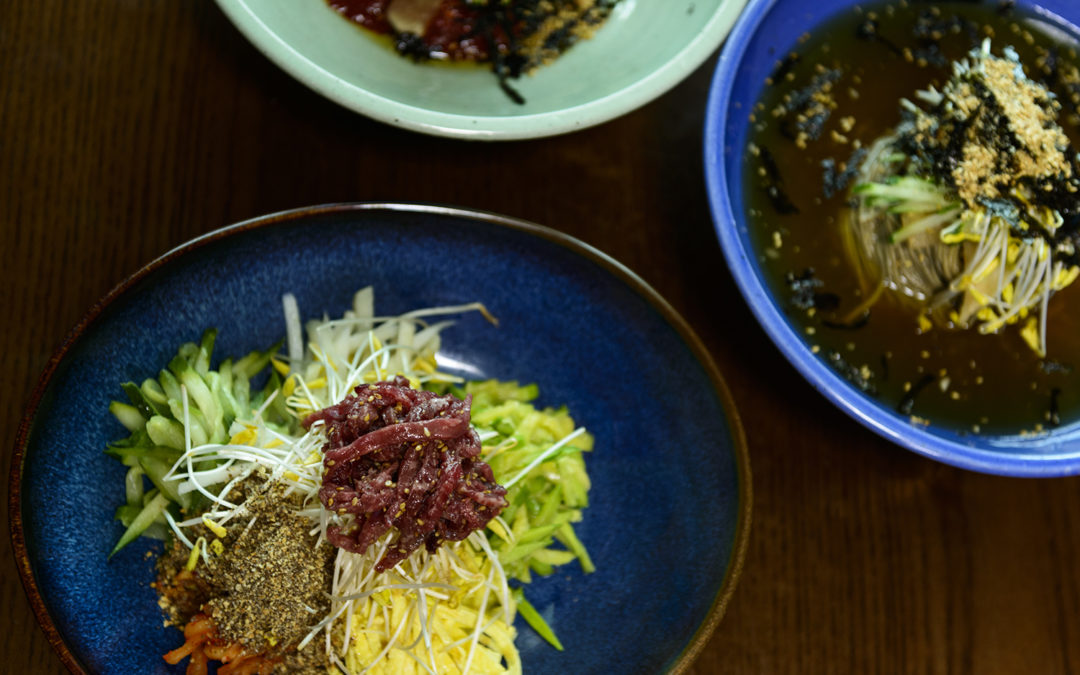Your Best Option for Traveling in Korea is to Learn the Hangul Aphabet
Download your Free Copy of our Korean Alphabet Primer and Read the Post Here
Visiting Pyeongchang Korea
There is a sleepy village in Korea that is known as Pyeongchang. If you travel the quiet streets and absorb the local culture, you could feel quite at peace with the country atmosphere. You might be blissfully unaware that soon the entire world will converge on this spot for the 2018 Winter Olympics. And, to be fair, the residents of Pyeongchang might be unaware as well. The country life of these humble people seems to continue on regardless of what the rest of the world seems to have planned for them.
Perhaps you are wondering as you read this, how a quiet country town on a hillside in Korea was able to contend with the onslaught of visitors that whisked through their location? How did they feed so many people? Well put your heart at rest.
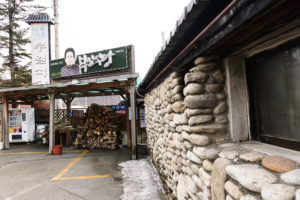
Buil Restaurant a traditional vegetarian restaurant in Pyeongchang Korea
One of the most amazing things about Korea is that no matter where you travel in the peninsula, you are never far from food or drink. Pyeongchang is no different. There are foods here for the most discerning eater, from a vegetarian diet to a full on five star western menu. You can even find a noodle restaurant that is home to the only Buckwheat Noodle Master of Korea.
Prior to this year, the quiet hamlet of Pyeongchang, Korea, was known mostly for its fish, preserved on log stands and dehydrated in the winter snow. Locally the fish is called Hwang Tae. It is a white pollack and is a main staple in the area.
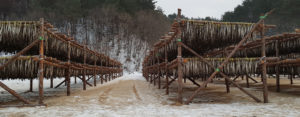
Hwangtae Fish Drying Racks in the Winter Snow near Pyeongchang Korea
You might catch a glimpse of the fish racks through your bus window and think that someone forgot to finish building their log cabin. But on closer inspection you will realize that there are hundreds of thousands of fish, half covered in snow, dangling from the logs on yellow strings. Fully exposed to the harsh winter weather, the fish is warmed and frozen repeatedly as the wind dehydrates the meat. Freeze dried foods are considered a newer innovation in western culture, but Korea would probably disagree with that estimation.
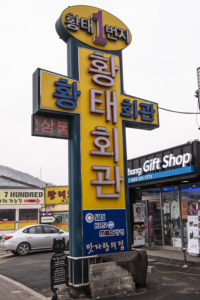
Hwangtae Restaurant sign in Hangul Korean Language, Pyeongchang Korea
Hwang Tae Shik Tang is named after this popular fish. There are preservation jars lining the walls like an anatomy museum. There are a few dining tables with chairs but most of the tables are long low and the clients sit on the floor. Famous for breakfast, if you visit this restaurant in the morning, you will be seated at one of the long tables with several other diners. The food is already prepared and plentiful, and you will have dishes in front of you minutes after you have been seated.
One of the main dishes available is Hwang Tae Gui is a grilled dry pollack. It is spicy and sweet with a with a chewy texture.
The other signature dish is Hwang Tae Hae Jang Kuk. This fish stew has a mild flavor and is similar to Egg Drop Soup, with Tofu and vegetables.
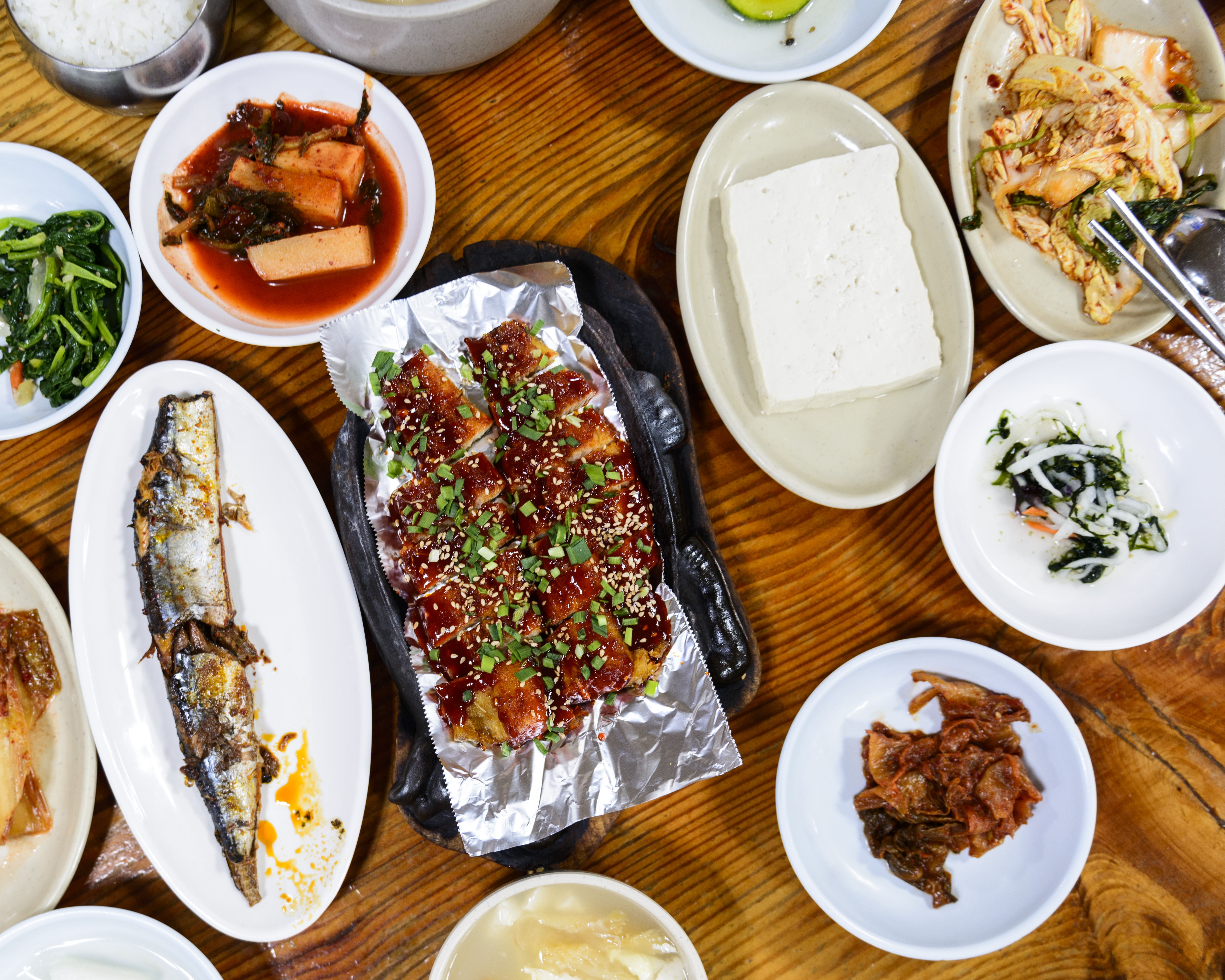
Hwangtae Fish Dinner with traditional Korean side dishes
The side dishes depend on the season, but you are certain to receive a variety of Kimchi. The restaurant serves a fresh cabbage Kimchi which is sweet and crispy. They also offer an aged Kimchi which has quite a bit more spice and a strong sesame flavor. The Pickled Turnip (ttok Bokke) is well aged and may be one of the best dishes of turnip in the region. The side dishes are all quite delicious and if you run out, which there is a good possibility you will, the hostess is quick to replenish the food.
For lunch, consider Buil Shik Tang. If there was an old west style restaurant that lived in Korea until the modern times, it would be the Buil Restaurant. Opened shortly after the end of the Korean War, this restaurant has remained virtually unchanged since. Mr. Yi Myong Hwan runs the restaurant now, and he still uses all of his grandmother’s recipes to prepare the meals.
Mr. Yi considers his restaurant a vegetarian restaurant, though there are a few dishes that contain the Hwang Tae fish. All of the ingredients are acquired locally by Mr. Yi, or gathered personally by him in the mountains or on his farm.

Chef and Owner of the Buil Shik Tang Restaurant in Pyeongchang Korea
“Many visitors are welcome to come try our traditional vegetarian meals,” said Mr. Yi.
The meals are plentiful, with as many as 22 different types of vegetables. You will be given a large stainless bowl with sesame oil in the bottom and you are welcome to mix as many of the vegetables as you like, with rice, to taste.
Everything is prepared over an open wood fire, and it presents itself in the flavors of the food. The one dried fish dish is very flavorful and tastes like a dry smoked tuna. You can clear your palate with pickled ginseng root which is mellow and delicious, then blast your palate with the Cabbage Kimchi which will attack your taste buds like gunpowder!
The Taenjang Chiggae is served boiling hot in a large ceramic bowl. It is dark and murky, and heavily spiced. It is like a nice French Onion Soup, with the kick of a mule!
There are fresh wild mushrooms, spinach, pickled ginseng leaves, and chestnut jelly. Too many side dishes to name. If you eat all of your favorite, you can happily call out for more!
The interior of the restaurant feels small and cozy, as it is divided into several very warm small rooms with long tables. You will be surprised to find out that this location has the ability to serve 300 people! Although this site has remained virtually unchanged since its inception, there will be a new location opening nearby on 10 February 2018. It will offer the same menu, but can seat as many as 450 people at more western style tables. The new location will be managed by Mr. Yi’s son.
If that lunch was not enough for you to finish out the day, and you find yourself wanting to continue your historical culinary tour of Pyeongchang, you should take your dinner at Narjak Shik Tang. This restaurant also boasts of more than fifty years of history in the region, though not in the same location.
“Narjak refers to the low roofed wooden houses which were once popular in the region, and is the style of building that the restaurant was first opened in,” says Song Bok, a cook at the restaurant whose grandmother founded the restaurant. “You can grill squid and pork belly on the fire for a quick meal.”
Anyone who has had spice pork or Sam Gyeop Sal in Korea is familiar with wrapping their food in a lettuce leaf, maybe tossing some taenjang and rice into the mix. But at Narjak Restaurant, the specialty is squid cooked with pork belly. The red sauce that the meat is marinated in is as spicy as you would expect it to be and the squid adds a unique texture to the dish.
Added to the main dish are sides of potatoes, black beans, bean sprouts, marinated peppers, and seaweed.
The short climb up the stairs has not hurt the restaurant’s popularity and you are sure to find many locals drowning the spiciness in soju or mokkeoli. The tables here are also communal, and should you shout a hearty “Kom Bai” to your neighbors, you are guaranteed not to drink alone for the remainder of the evening. You are also sure make several new friends, but write down their information, because it is likely that you will not remember much in the morning.
If traditional Korean food is not to your taste, or if you feel the urge to experience western style cuisine in Korea, you will be welcomed at Cafe Fleuri. Although the theme of this restaurant is in a country cafe style, it is in the spacious lobby of the five-star Kensington Flora Hotel, and you will be treated in a five-star manner.
The lobby of the hotel itself has a large collection of Olympic Memorabilia. You can see several signed photos, training gear, and medals from different athletes through the history of the Olympics. This alone is good reason to visit the Cafe Fleuri.
Once you pass the indoor fountain, you will see the country-white cottage doors of Cafe Fleuri inviting you in. There is a chandelier made of water pitchers and large coffee mugs that will greet you as you enter. Large wooden barrels line the walls along with a large selection of wines and teas to choose from.
If you are not in the mood for a large meal, you can sit in the cafe area, which is graced with large comfortable chairs and flower decorations. Whether you choose coffee, tea, or wine, you can enjoy a chocolate torte cake with your drink, or plain cheesecake with just a hint of lemon. If you decide on coffee, you will get a proper mug of coffee, filled nearly to the brim, with just enough room for sugar and cream, if that is to your liking.
In the dining area, the decor continues, and everything is arranged with a familiar sense of organization that you may have never realized you have grown accustomed to in western society.
First cook, Hong Jong Ho, said that he majored in Western Cuisine and the hotel sends the staff to workshops on a regular basis for extra study.
Hong’s favorite meals to prepare are the steak and pasta.
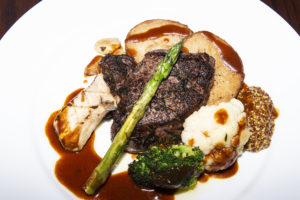
Steak Dinner with Asparagus in Kingston Hotel, Pyeongchang Korea
“We chose the Korean Beefsteak because this area is very popular for beef,” said ChaEui In, a host and associate who has worked in the restaurant for the past two years. “We wanted to create this dish to compliment the western palate.”
The tenderloin steak is a very generous cut of meat, at least two inches thick. It is crusted with Rosemary and served with roasted garlic, asparagus, mushrooms, potatoes and cauliflower. The vegetables are dressed in a beef bourguignon style reduction sauce, which will compliment the meat nicely.
The lasagna is served in a 12 ounce oval boat dish and could easily be shared by two light eaters. The balance between the meat and cheese is perfect without either overpowering the other. The sauce is slightly sweet and blessed with a large helping of mushrooms.
The atmosphere in the restaurant is made for conversation, with light adult oriented rock music playing softly in the background. Everything about this restaurant and hotel speaks to the approachability of the staff and the comfort that is expected from a fine establishment.
“This hotel is well organized to offer better service and comfort,” said Cha. “In Korean tradition it is very difficult to approach managers in the workplace, but here the staff is very open to suggestions.”
After your meal, you can tour the hotel grounds. You can enjoy a leisurely stroll around the lake, view the gardens, and have photo opportunities in the large king and queen thrones. There is also a glamping site, for the more adventurous spirit of luxury.
Still, after all of this, Pyeongchang holds more surprises for you. Regardless of whether you prefer Western Style cuisine, Korean, or something else entirely, you absolutely must visit Mi Ga Yeon Restaurant!
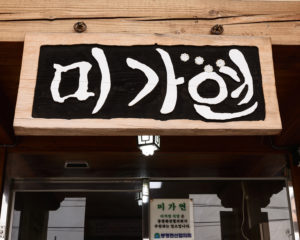
Hangul Lettering reading Migayeon outside of a restaurant in Pyeongchang Korea.
Mi Ga Yeon is a completely unique experience in dining culture. It was created by Oh Sok Hui who is an amazingly humble soul and wonderful storyteller! Her love for life and art is reflected in the careful preparation of her dishes. She has considered everything from the colors of the ceramic dinnerware which was created by a local artistic potter, to the tales that she regales her guests with while they dine. Her food and stories both come from the heart, and both have a special morale woven throughout that will enlighten your essence.
One of the offerings in this beautiful restaurant is Buckeye Bud Juice. It is a combination of Buckeye Wheat and Yogurt.
“You can tell the age of someone who drinks the juice by the flavors they say that they taste,” explains Oh. “In your 30’s you think you taste apples in the juice, in your 40’s you will say it tastes like ginseng and if you have passed your 40’s you might think it tastes like Japanese Yam.”
Oh says that after she has let her guests try the juice and talk about the flavors, she then explains how different ags taste different flavors. Once she has explained this, everyone agrees, and they all say it certainly taste like apples.
Oh was presented a Department of Industry award for new menu items and patents that she has created and for her charity work. It is very rare for a restaurant owner to receive this award. She is also the only Master of Buckeye Wheat Food Preparation in Korea.
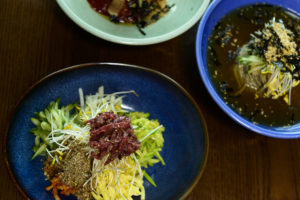
Raw Beef bibimbap, mixed vegetables.
She is very passionate about Buckeye Wheat. She went bankrupt three times pursuing the perfect venue to present her meals. She had been studying bibimbap and had reached a level where she had become quite confident in her recipes. Then she switched from a Bean Sprout to the Buckeye Wheat Sprout. It became so popular that she got the idea to create a Buckeye Wheat Noodle.
She realized that the quality of her ingredients was the most important factor in her recipes. This taught her humility and a love for the best, locally purchased ingredients.
Her love for the ingredients certainly shows in the meals that she presents. There is a Raw Beef Bibimpap with potato, zucchini, Buckwheat Sprouts, cucumber, radish and eggs. All the flavors marry perfectly together, and Oh avoids the more common ingredients such as carrots.
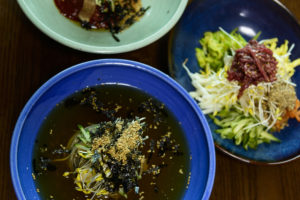
Knife Cut Noodles or Iced Noodles is a popular Korean dish served in the Summer
Yatche Mandu are plump dumplings with a little pork and filled with vegetables. Buckwheat Crepes are similar to the mandu, but are vegetarian, without the pork, and are made from 100% Bitter Wheat, which gives the wrapper more texture. All of the noodles and wrappers are made in house.
There are two types of buckwheat, Sweet Buckwheat which has a large triangular shape and Bitter Buckwheat which is smaller and resembles Sesame. Bitter Buckeye has 7 times more Rutin than Sweet Buckwheat and, as far as Oh is aware, her restaurant is the only one that uses the Bitter Buckwheat. This is what gives their noodles and wrappers such a unique flavor.
In addition to her love for the Buckeye Wheat, Oh’s careful meal preparation extends to her Kimchi which is aged for a full five years, and she only uses wild sesame oil in her dishes.Suddenly you feel a slight pang of regret for the great King Sejong, who never had the opportunity to dine this well.
Taste, however, is only 50% of the dining experience, says Oh. The rest of the experience is in storytelling and atmosphere. People from around the world are coming to Pyeongchang for the olympics and she feels that this is her opportunity to present the Buckwheat Noodle to the world.
“You have to do what you love, said Oh. “This is our stage, and where we can dance.”

